The future of flight: Recovery, growth and decarbonisation
As we return to the skies for that first face-to-face meeting, reuniting with family or taking that well-deserved holiday, the airports we pass through will be markedly different to what we knew before. These changes might not be immediately obvious as you pass through security, browse duty-free or board your plane; but the implications are significant for investors.
Will I ever see your face again?
Much has been made of the transformational impacts that the
pandemic has had on the way we work and communicate.
With an endless number of studies and surveys pointing to
varying levels of structural declines in business traffic as a result
of the rapid shift towards virtual communication.
Anecdotally we can look towards Mexico for an indication of how
things might progress, with Mexican air travel now returning to
pre-pandemic levels we have seen some divergence in the
recovery based on the passenger mix of an airport.
As demonstrated below leisure exposed airports (such as
ASUR’s Cancun Airport) have seen a very strong recovery in
traffic as vaccination rates have increased, whilst more business
exposed airports have lagged in their recovery (such as OMA’s
Monterrey Airport).
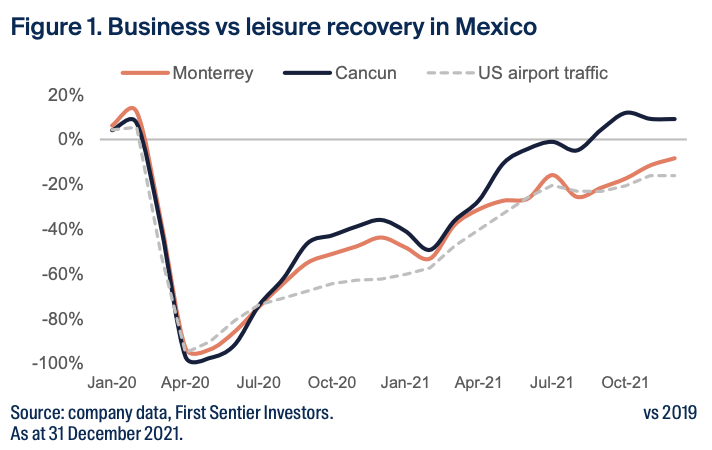
Whilst the magnitude of the difference in Mexico is not necessarily
directly translatable to other parts of the world, with differences in
the purpose and distance of business travel being large factors in a
decision to travel, we believe the principle will broadly hold across
regions. This view is supported by a recent Bloomberg survey of
large US corporates that found 84% expect to spend less on travel
post-pandemic. A change that can largely be attributed to the
shift to virtual meetings, with Morgan Stanley finding that corporates
expect this to take 29% of volumes in 2022 and 19% in 2023.
We forecast a 20% structural loss in long-haul passenger travel as a
result of multiple headwinds, the largest of which is lower demand
for corporate travel. As a result, we favour more short-haul, leisure
exposed airports. Particularly European airports with large Intra Europe exposure, where the rigours of border restrictions are likely to
be less cumbersome. We expect to see a strong rebound in traffic
as travellers look to catch up with friends & family and take a holiday,
an investment thesis we have seen successfully play out in Mexico.
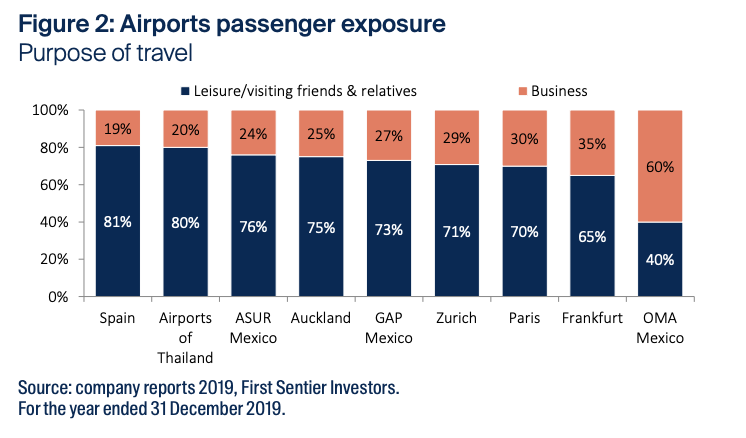
Goodbye to the big jet plane
The pandemic has seen hundreds of planes laying idle on airport
tarmacs and deserts throughout the world, waiting to return to the
skies. For some superjumbos that previously dominated the skies
like the Airbus A380, this day may never come. The impacts of the
pandemic and the changing economics of flying have led many of
the world’s airlines such as Air France, Lufthansa, Qantas, Qatar
and Singapore Airlines to significantly reduce or in some cases
even fully retire their A380 fleets.
Airlines are increasingly shifting their fleets towards smaller, more
fuel-efficient and more flexible aircraft for long-haul operations. The
clearest example of this is the shift from the ~550-seat Airbus A380
aircraft to the ~300-seat Boeing B787 Dreamliner. The implications
of this shift for airports are two-fold; the first consequence is that
more planes need to land and take-off to cater to the same number
of passengers as they did in 2019. This is posing a potential problem
for airports that suffer from runway capacity constraints and had
benefitted from the scale of the A380 as a result.
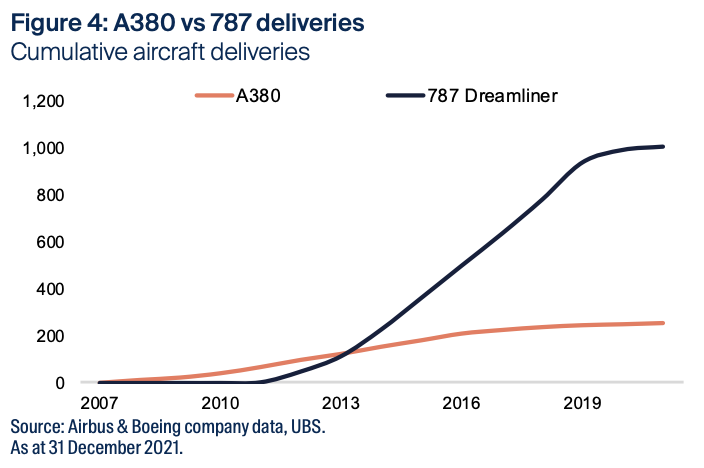
The second impact, which has more long-term and significant
consequences, is the shift that is slowly occurring in airline
route planning. With early signs of a transition in the global aviation
structure from the hub-and-spoke model favoured by most
long-haul airlines today to an increasingly point-to-point model.
In the hub-and-spoke model, airlines serve passengers by
filtering them to ‘hub’ airports and then connecting passengers on
to their final destination via large aircraft to create economies of
scale. Whilst under the point-to-point model the airline instead
creates more direct routes serviced by smaller planes to take the
passenger direct from point-A to point-B.
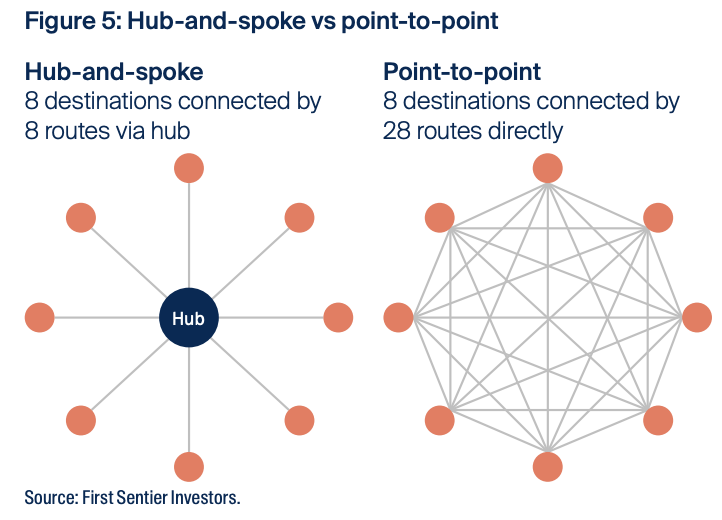
The implications of this are that airports which previously served
as these ‘hubs’ face the risk of large structural declines in this
portion of traffic that previously transited through their airport.
These passengers are referred to as ‘transfer’ passengers;
meaning that the airport is not their city of departure nor final
destination but rather where they connect on to an onward flight at
the airport.
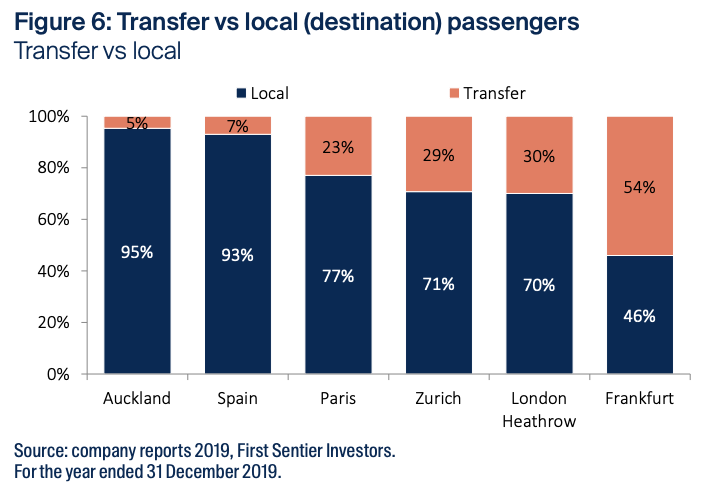
As a result of these risks, we favour those airports with more limited exposure to transfer passengers. Preferring ‘destination’ airports whose traffic is driven by economic or tourism factors that necessitate travel to that specific airport. An example of this is Aena, the owner and operator of 46 airports and two heliports throughout Spain. This includes airports in destinations such as Barcelona, Madrid, Mallorca and Ibiza. As a result, Aena’s airports are the initial departure point or final destination for 93% of their passengers.
More than just terminals & runways
One of the bright spots for airports during the pandemic has been
the real estate segments of a number of the listed airport
companies. These assets have provided a steady stream of
income with little-to-no correlation to the suppressed passenger
traffic, with many airports benefitting from the increased demand
for cargo/industrial from e-commerce tenants in response to the
boom in online shopping as a result of the pandemic.
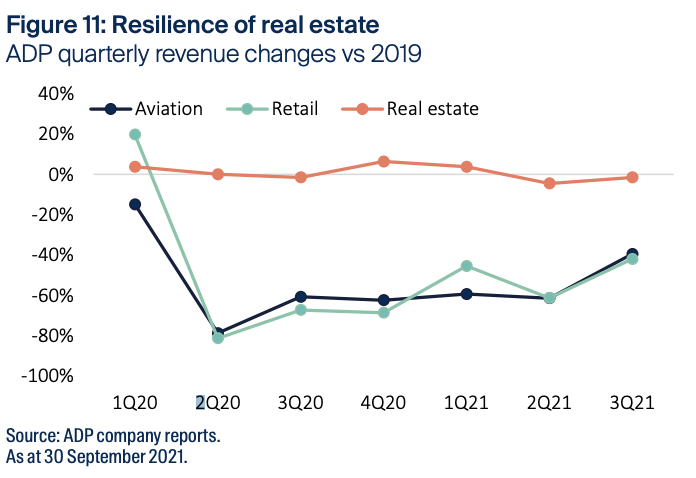
Airports typically sit on substantial land banks to facilitate airfield
growth and protect residents from noise intrusion. These landholdings have allowed airport operators to develop this surplus
land into substantial property portfolios, which typically
incorporate a mix of commercial, industrial, hotel and
retail tenants.
The pandemic has accelerated this trend toward real estate, with
airport groups increasingly focusing on these activities.
Many airports have sought to establish joint-ventures with major
real estate firms, allowing them to monetise this land without
significant capital outlay being required.
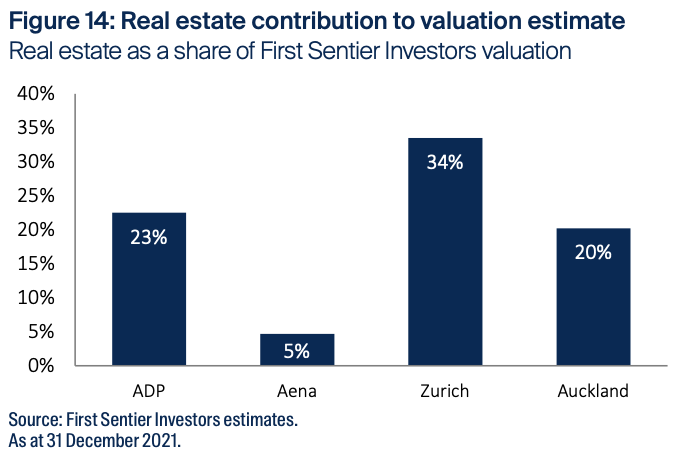
China reopening tailwinds or is the growth engine slowing?
China has been a key source of growth in the aviation industry for
the past 20-years, with the expanding middle class in China
leading to a 12% compounded annual growth rate in air travel
between 2006 and 2019.
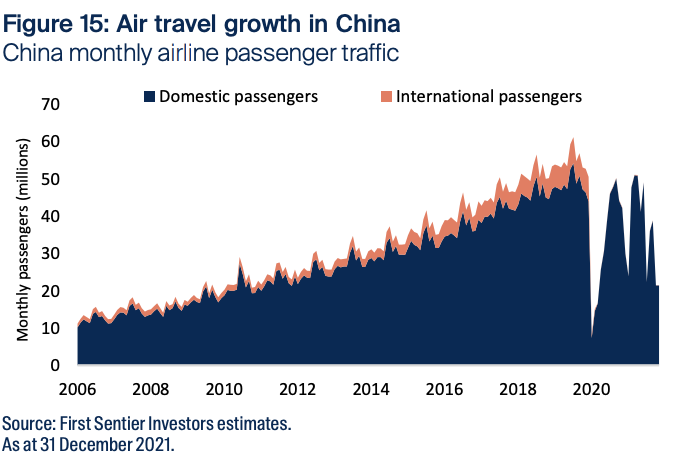
In addition to the growth benefits that the aviation industry has
seen from this evolving market, airports have further benefited
from the high retail spend rates from these passengers.
We estimate that Chinese travellers spend 4-5x that of the
average passenger, meaning that any change in traffic has a
disproportionate impact on earnings for the airports.
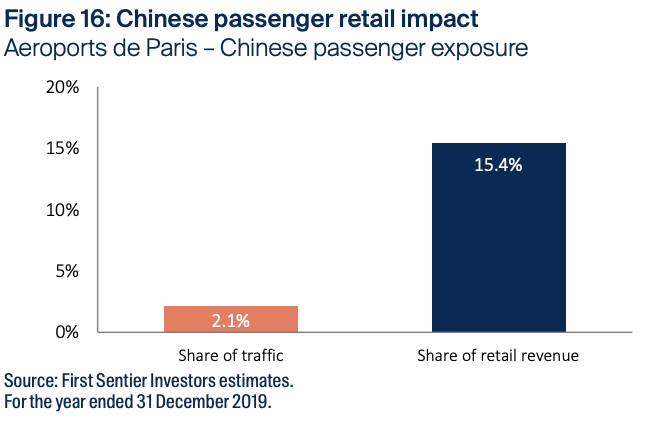
However, the pandemic has seen China’s borders shut for over two years, adopting a zero-COVID approach whilst the rest of the world seeks to find a way to live with the virus. The Chinese Government is yet to provide an indication of when these border restrictions may ease, although we can look towards events in 2022 that provide insight into a potential timeline. In February 2022, Beijing hosted the Winter Olympics, whilst in October the communist party will hold its twice a decade party congress.
We believe it is unlikely that a widespread reopening will occur prior to these events, with our assumption being that a meaningful reopening will commence from late-2022.
Taking this analysis one step further and considering how
significant this is from an earnings perspective we estimate that
Chinese travellers were responsible for as much as 14% of
pre-COVID EBITDA in the case of Auckland Airport. Whilst at the
other end of the scale we estimate that this market contributed
less than 1% of pre-COVID EBITDA for Spain’s Aena.
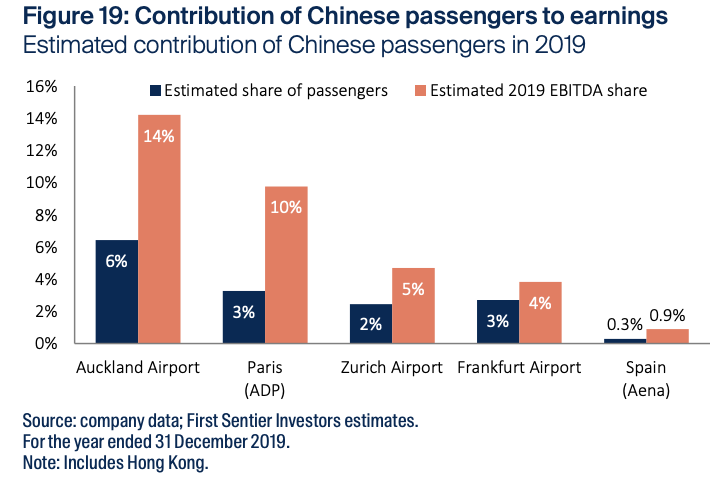
A flight path to net-zero
Greater action on climate change is a positive not only for the planet, but also for the infrastructure asset class. Presenting opportunities for a number of our portfolio companies to help facilitate this decarbonisation process. However, careful consideration should be given to the pathway to net-zero and the impact this will have on airports and their operations. Whilst airports do not directly produce significant amounts of carbon themselves, their facilitation of air travel leads to material carbon emissions.
Collectively the transport sector accounts for ~24% of global anthropogenic CO2 emissions, with aviation responsible for ~11% of transport emissions or ~3% of total emissions.
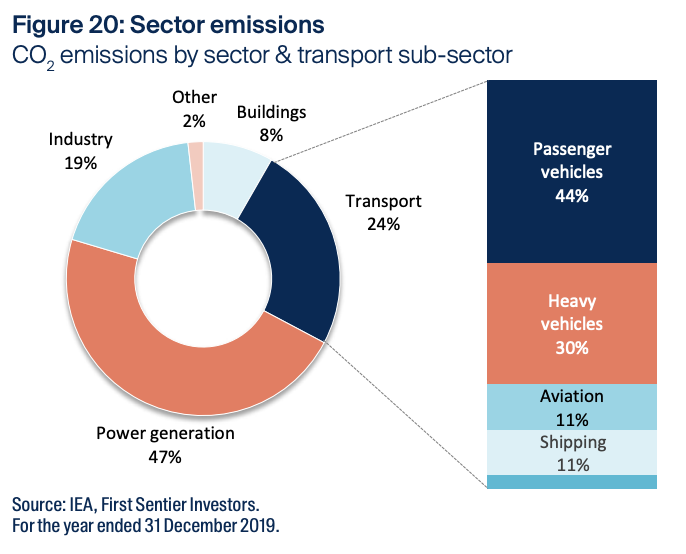
The path to decarbonisation for the aviation sector is a process of
gradual improvement that can be thought of in three distinct
phases. The first is the improvement in aircraft efficiency, the
evolution of aircraft since the start of the jet-age has seen
significant advancements in jet engine design and composite
fuselage materials for improved fuel burn efficiency.
Allowing airlines to reduce not only their fuel costs to make
aviation more affordable, but improve the impact that these
operations have on the environment. Developments have
accelerated in recent years, with the latest aircraft up to 25%
more fuel burn efficient than the previous generation aircraft.
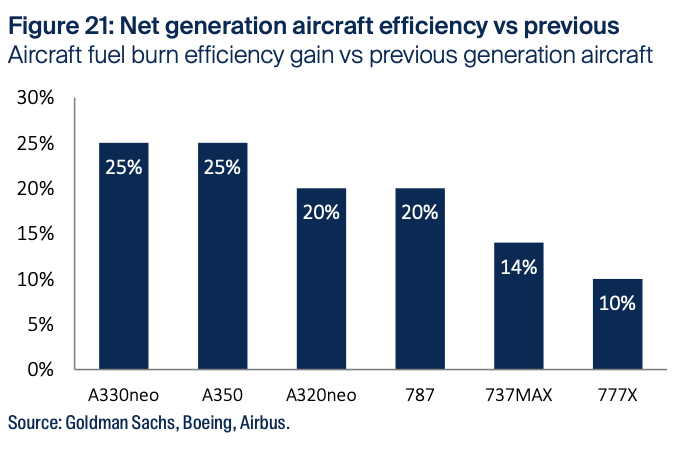
The second stage is the broader adoption of sustainable aviation fuels (SAFs) by airlines. SAFs are developed from renewable sources such as cooking oil, municipal waste and woody biomass, serving as an alternative to conventional jet fuel. These alternative fuels are estimated to reduce aircraft lifecycle emissions by up to 80%. However, at present the cost of SAFs is 3-4x that of conventional fuel, with SAFs only accounting for 0.1% of all jet fuel consumptions as a result. Significant investment is required to increase the supply of SAFs to make the technology more affordable and allow greater adoption.
The third and final stage is the development of new zero-carbon
impact propulsion technologies. These include the development of
electric and/or hydrogen propulsion systems. These technologies
are required in order to achieve the ultimate goal of net-zero
emissions from the sector, however it is important to note that
these technologies are unlikely to reach widespread adoption
before 2040. As a result, the immediate focus is undoubtedly on
promoting the use of SAFs in order to ensure the sector can
continue to grow in a decarbonising world.
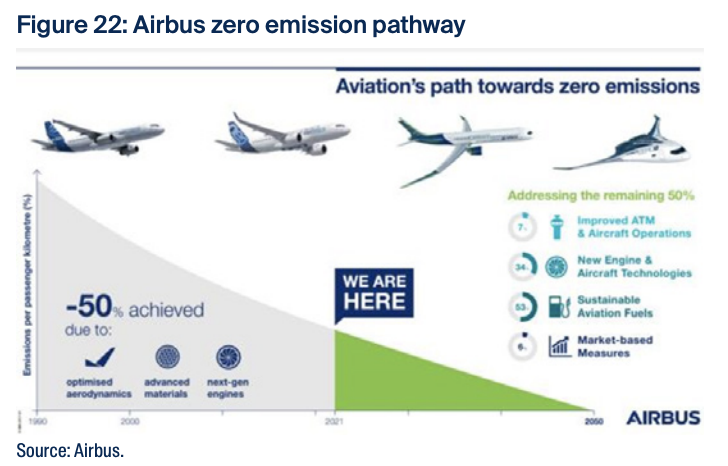
The more immediate impact of this decarbonisation process for
airports is the push towards high-speed rail as a lower carbon
footprint transport alternative to air travel. We are increasingly
seeing governments introduce measures to encourage
high-speed rail via cost incentives and increased investment to
reduce travel times on key routes. We consider any journeys
which can be completed via rail in six hours or less to be at risk of
disruption from these measures.
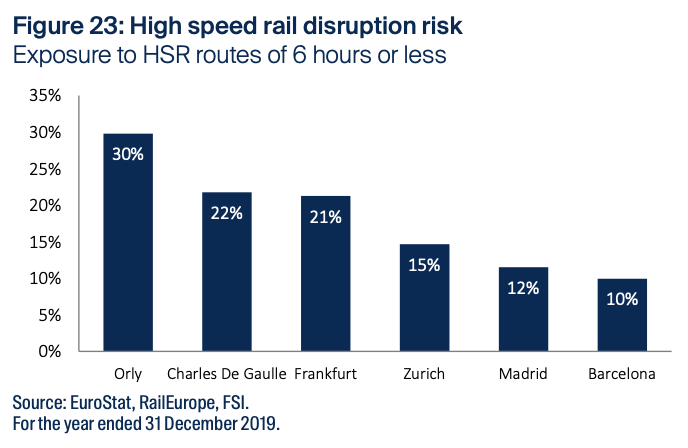
As a result, we favour those airports that serve populations that have limited or no high-speed rail alternatives. We see these airports as not only serving a vital social need to connect communities, but also at a lower risk of having their traffic disrupted by high-speed rail competition.
Conclusion
Whilst the pandemic continues to impact the way we live our lives, the clouds are slowly clearing on a path towards a return to some form of normalcy.
As this situation continues to develop we maintain our preference for short-haul, leisure exposed airports. Seeing fewer structural risks for these assets, with permanent traffic losses more limited and a greater number of positive catalysts for growth in the medium-term.
Looking beyond this recovery story we believe it is important to consider the lessons and changes for airports that have occurred as a result of the pandemic. As these developments will have significant impacts on the way these businesses operate and grow in 2022 and beyond.
The sector provides many opportunities for investors to gain exposure to multiple economic and social growth drivers in both developed and emerging markets. We are particularly optimistic about the growth potential of the real estate assets held by these companies, with these land parcels being highly valuable in an e-commerce economy that requires increased air freight and intermodal facilities.
However, investor caution is required when considering the
impacts of developments in the decarbonisation of the
transportation sector and structural changes in China’s duty
free market. Navigating these challenges will become increasingly
important as air travel returns to some semblance of normality.
We believe that the portfolio’s current position provides positive
exposure to the structural growth in global air travel, whilst
ensuring that these sector risks are managed appropriately.
Note: You can find the full report in the attachment below
Learn more
We invest in shares of infrastructure companies around the world, including operating assets from the transport, utilities, energy and communications sectors. The assets held by these companies typically offer high barriers to entry, pricing power, and structural growth. For further information, please visit our website.
5 topics

